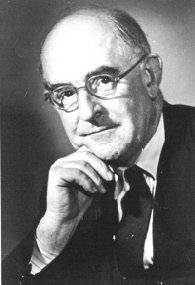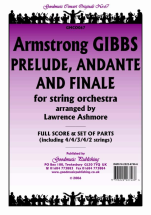Prelude, Andante & Finale, Op. 112
Buy this item (in stock)
Product ID: GM2 CO067
By Cecil Armstrong Gibbs
published: 1946
Publisher:
Goodmusic
Series:
Concert Originals
Line Up:
String Orchestra (Solo: Bassoon)
Duration:
18:00
Set & Score
This item is in stock
About this item
Known
principally for his solo songs, Armstrong Gibbs also wrote music for the
stage, sacred works, three symphonies and a substantial amount of
chamber music, much of which remains unpublished. Armstrong Gibbs was
born near Chelmsford in Essex and spent much of his busy life there when
he was not touring the country adjudicating at festivals, conducting
and composing.
The manuscript of this work is dated 17 July 1956 and closely
follows Walter de la Mare's death in June of the same year. It has been
described as one of Gibbs' most deeply felt compositions and is scored -
like Vaughan Williams' Tallis Fantasia and Elgar's Introduction and
Allegro - for solo string quartet and string orchestra. Note that there
are THREE separate violin parts rather than the conventional two.
Instrumentation
Orchestration
String Quartet:- Solo Violin 1, Solo Violin 2, Solo Viola, Solo Cello
String Orchestra:- Violin 1, Violin 2, Violin 3, Viola, Cello, Double Bass
A PACK comprises one full score, one of each of the quartet parts and string orchestra parts 4/4/4/3/4/2.
Reviews and rating
No review available, be the first to write one!

Composer
Cecil Armstrong Gibbs (1889-1960)

Cecil Armstrong Gibbs (10 August 1889, Great Baddow, Chelmsford, Essex – 12 May 1960, Chelmsford, Essex) was an English composer. A monument on the north chancel wall of the church of St John the Baptist, Danbury, Essex states that "He lived, worked and is buried in Danbury".
He studied with Edward Dent at Trinity College, Cambridge, and with Charles Wood and Ralph Vaughan Williams at the Royal College of Music, where he himself taught composition and music theory from 1921 to 1939. From 1937 to 1952, he also served as the Vice President of the British Federation of Music Festivals.
Amstrong Gibbs composed one opera, one operetta, incidental music for several plays, several cantatas, three symphonies, a concertino for piano and string orchestra, five string quartets, one violin sonata, pieces for piano, works for choir, and many songs, a great number of which were settings of texts penned by his friend Walter de la Mare.
More info about the composer...



 Click above to view samples
Click above to view samples
